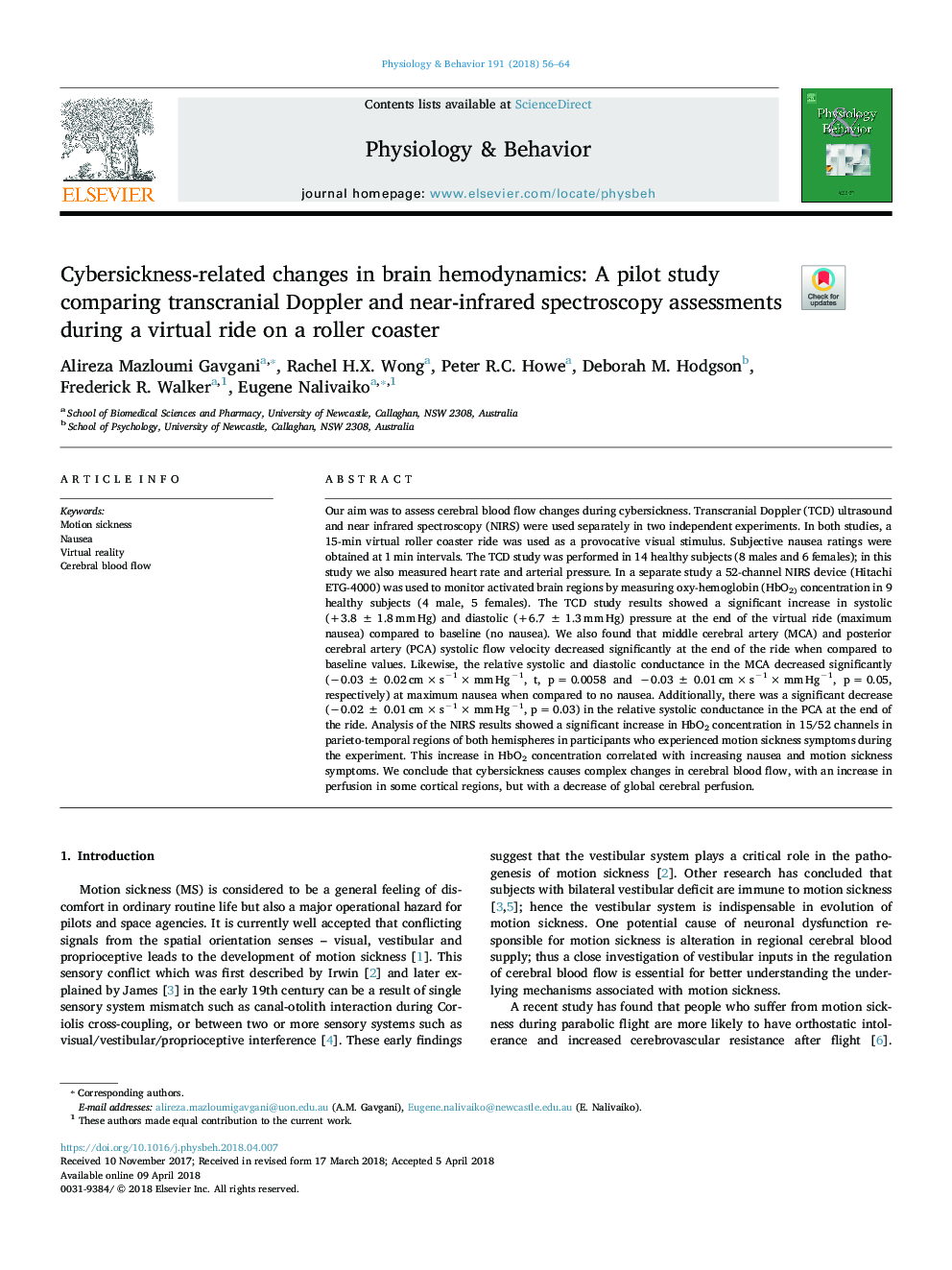| کد مقاله | کد نشریه | سال انتشار | مقاله انگلیسی | نسخه تمام متن |
|---|---|---|---|---|
| 8650494 | 1571128 | 2018 | 9 صفحه PDF | دانلود رایگان |
عنوان انگلیسی مقاله ISI
Cybersickness-related changes in brain hemodynamics: A pilot study comparing transcranial Doppler and near-infrared spectroscopy assessments during a virtual ride on a roller coaster
ترجمه فارسی عنوان
تغییرات مربوط به سیبریسکی در همودینامیک مغز: یک مطالعه آزمایشی با مقایسه مقادیر داپلر ترانس کرانانی و طیف سنجی نزدیک به مادون قرمز در طی یک سواری مجازی در یک غواصی
دانلود مقاله + سفارش ترجمه
دانلود مقاله ISI انگلیسی
رایگان برای ایرانیان
کلمات کلیدی
دریازدگی، حالت تهوع، واقعیت مجازی، جریان خون مغزی،
موضوعات مرتبط
علوم زیستی و بیوفناوری
بیوشیمی، ژنتیک و زیست شناسی مولکولی
فیزیولوژی
چکیده انگلیسی
Our aim was to assess cerebral blood flow changes during cybersickness. Transcranial Doppler (TCD) ultrasound and near infrared spectroscopy (NIRS) were used separately in two independent experiments. In both studies, a 15-min virtual roller coaster ride was used as a provocative visual stimulus. Subjective nausea ratings were obtained at 1â¯min intervals. The TCD study was performed in 14 healthy subjects (8 males and 6 females); in this study we also measured heart rate and arterial pressure. In a separate study a 52-channel NIRS device (Hitachi ETG-4000) was used to monitor activated brain regions by measuring oxy-hemoglobin (HbO2) concentration in 9 healthy subjects (4 male, 5 females). The TCD study results showed a significant increase in systolic (+3.8â¯Â±â¯1.8â¯mmâ¯Hg) and diastolic (+6.7â¯Â±â¯1.3â¯mmâ¯Hg) pressure at the end of the virtual ride (maximum nausea) compared to baseline (no nausea). We also found that middle cerebral artery (MCA) and posterior cerebral artery (PCA) systolic flow velocity decreased significantly at the end of the ride when compared to baseline values. Likewise, the relative systolic and diastolic conductance in the MCA decreased significantly (â0.03â¯Â±â¯0.02â¯cmâ¯Ãâ¯sâ1â¯Ãâ¯mmâ¯Hgâ1, t, pâ¯=â¯0.0058 and â0.03â¯Â±â¯0.01â¯cmâ¯Ãâ¯sâ1â¯Ãâ¯mmâ¯Hgâ1, pâ¯=â¯0.05, respectively) at maximum nausea when compared to no nausea. Additionally, there was a significant decrease (â0.02â¯Â±â¯0.01â¯cmâ¯Ãâ¯sâ1â¯Ãâ¯mmâ¯Hgâ1, pâ¯=â¯0.03) in the relative systolic conductance in the PCA at the end of the ride. Analysis of the NIRS results showed a significant increase in HbO2 concentration in 15/52 channels in parieto-temporal regions of both hemispheres in participants who experienced motion sickness symptoms during the experiment. This increase in HbO2 concentration correlated with increasing nausea and motion sickness symptoms. We conclude that cybersickness causes complex changes in cerebral blood flow, with an increase in perfusion in some cortical regions, but with a decrease of global cerebral perfusion.
ناشر
Database: Elsevier - ScienceDirect (ساینس دایرکت)
Journal: Physiology & Behavior - Volume 191, 1 July 2018, Pages 56-64
Journal: Physiology & Behavior - Volume 191, 1 July 2018, Pages 56-64
نویسندگان
Alireza Mazloumi Gavgani, Rachel H.X. Wong, Peter R.C. Howe, Deborah M. Hodgson, Frederick R. Walker, Eugene Nalivaiko,
